As promised, here are my first adventures with my new book, Sew What! Skirts by Francesca DenHartog.
KathyR asked, “Can an impatient novice with a low end sewing machine accomplish any of these skirts? Not -cough- that I know anyone like that.” Yes, absolutely. This is a book for people who know how to sew straight lines and how to take their measurements. If you know how to use the buttonhole feature of your sewing machine, great! If not, no problem, you can still make skirts with elastic waistbands. I like zippers, so if you can put in a zipper, you’re golden (If you've never put in a zipper, DenHartog talks you through it, it’s really easy). So, Kathy, you can go ahead and tell your friend that she should give it a try.
The book begins by explaining how to make an individualized pattern for the two basics: the A-line skirt and the fitted straight skirt.
First, as you all know, I made an A-line skirt with that blue and black fabric. Cate commented, “I like how the stripes are not quite vertical.”—Erm, that would be because I folded the skirt in half when I took the photo the other day. As you can see, I did cut the fabric along the grainline (sorry this one’s so fuzzy):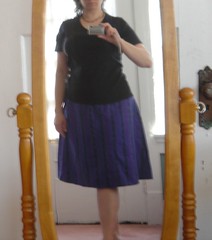
Here’s a side view: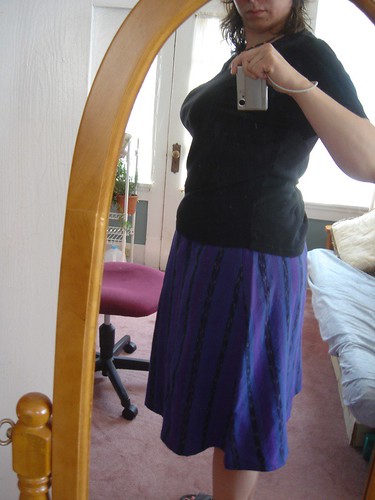
The next day, I used the red stripey fabric and made a straight skirt, with an attached pleated bottom edge, so I’d be able to walk in the thing without needing a slit up to there: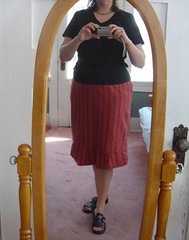
And, because I’m enjoying myself, another side view: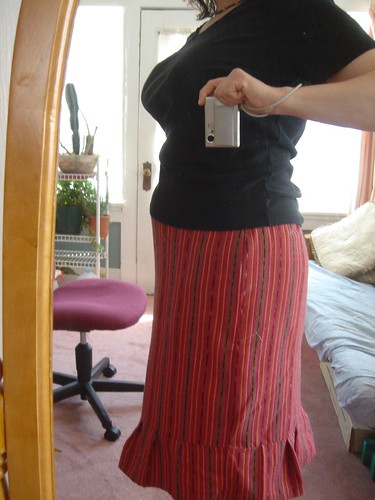
The book suggests different ways to finish the top of your skirt. You can add a sewn-in waistband, you can add a facing (which helps it sit more smoothly on your waist), or you can just add bias tape. "Bias tape?! How slipshod! I would never finish with bias tape! How unprofessional!" I thought to myself (remember this bit of pretension later, OK?). So I made facings for these two skirts. Because I had very little red left after cutting out the skirt pieces, I improvised with the facing for that one:
Now, what I used clearly doesn’t “go”, but considering no one will see the facing but me, I let it be. I like this idea of using different fabric for facings (it makes for a little surprise when dressing, and really, who doesn't need a little "surprise!" in the morning? [as long as it isn't of the "ooops, I must have eaten too many of those cinnamon rolls!" variety]). I’ll be using this random facing idea more often. But—probably not this random, next time.
I should mention about here (because you may have just noticed the turquoise zipper) that I was able to do this unplanned sewing in part thanks to a yard sale purchase from, oh, about four years ago. My eye caught sight of a box of zippers, for some unbelievably low price—maybe $5 for a shoeboxful?—and I brought the shoebox home, where I promptly put it aside. I mean, really, zippers in colors such as fuschia, teal, spinach, and tomato bisque? What was I thinking? Who would ever need zippers in such godawful colors? 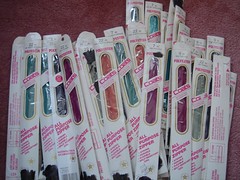
Clearly, the four-years-in-the-future me. (Because if you put the zipper in correctly, others won’t ever see the tomato bisque zipper.)
As I said, If you’ve never put in a zipper, don’t worry, the author explains how to do it. She also shows you how to make a drawstring binding, and a sewn-in elastic waistband. (There’s also a description of how to make a sewn-in waistband with buttonhole closure above a zipper. But that would take more cut pieces than I wanted to do this week.)
I was on a roll, and I wanted to make the wraparound skirt included in the book. Now, here is where I ran into some trouble, and I believe it’s due to a typo in the book. I could be wrong, but so far I haven’t been able to explain it any other way.
There is a pattern for a skirt made from two half circles, sewn together. It looks very nice; but it takes over 5 yards of fabric. You fold the fabric, take your waist measurement, divide it by 6, and use a piece of string and your chalk pencil (actually, I used a graphite pencil; these are easy breezy summer skirts, after all) to mark the arc for the waistline cut and the hemline cut (sounds difficult, but it’s not; I’m just setting the stage for you). But! The author says, you can use the same idea to make a wraparound skirt, with only half as much fabric. Simply add about 12 inches to your waist measurement (for the overlap), before dividing by 6, and use that number for the arc line. Except—this makes one half circle (plus the 2 extra inches), the half circle which represents HALF of your waist. (Are you following me? For the wraparound, you should divide by THREE, not SIX, since the half circle will become your ENTIRE waist measurement, rather than half of your waist measurement.)
Right now, most of you are probably thinking, “Huh?”
That’s exactly what I was thinking after I cut the semicircle and put it up to my waist. There was no way I’d be able to wrap that thing around my waist. I tried it around Impera’s waist, and there was no way I could make it work for her, either….
“Oh…,
Trixie!…..”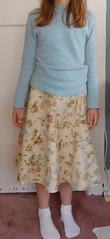
I used the semicircle, but sewed up both edges, because a wraparound just isn’t practical on a playground. She loves the swishing swirliness of it: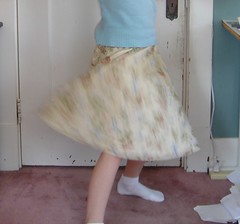
(I normally wouldn’t cut off her head in photos, as you know, but the poor kid had to have a filling replaced today, so the entire left side of her jaw was swollen and she looked pretty darn awful, believe me.)
I re-did the skirt in a similar fabric for me, but dividing by 3, rather than 6. I decided I like a little swish in my sashay, too, so I sewed mine closed like I did for Trixie: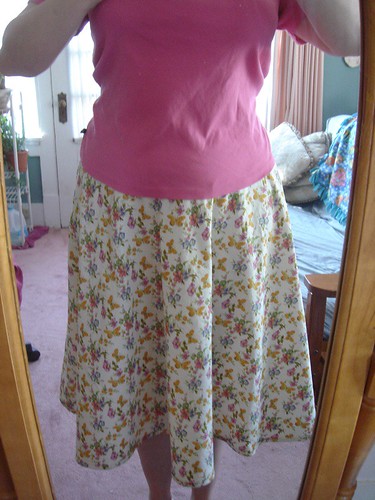
I used my handy-dandy bias tape maker (best darn sewing tool I’ve purchased in a long time!):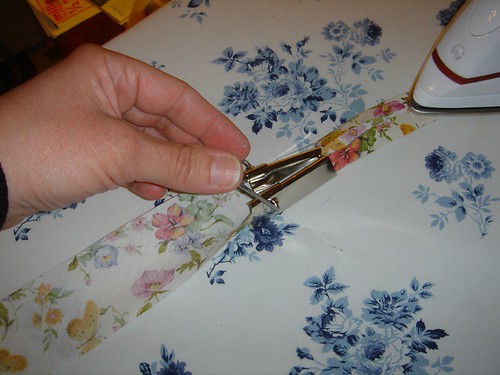
to make enough bias tape to finish the top and bottom edge of both semicircle skirts (Yeah, yeah, eating my words; but hemming a really curved edge is a bitch to do, and I didn’t feel like cutting out any more fabric for waistbands.)
To sum up, I’ve had fun with this book, and I plan to make several more skirts for this season (including one for Impera, whether she wants one or not; are you reading this, missy?). Except for that one typo, the directions are easy to follow. The most important aspect of this book is the confidence it gives a nonseamstress (like me or you) to make something without a purchased pattern. Split Sister asked, “Can I have a skirt too?” Which I would have to answer—No. Making a skirt in this way necessitates some tweaking. Everybody’s curves are different, and I did have to adjust the angle of the A-line so that it looked good to me (there was too much flare if I followed the recipe to the letter). So I really believe anyone could make themselves a skirt using this book; but you’d just have to do it for yourself (and Split Sister, I know you have a sewing machine!).
I am a freelancer in the publishing industry, so words are very important to me. I'm a leftist living in a world gone mad, so politics are very important to me. I'm an environmentalist living in a degrading world, so pick up your damn trash, get rid of your gas guzzlers, and don't touch ANWR, you self-absorbed capitalists!
Do leave comments: let's make this a conversation. If you prefer, you can contact me at friuduric at yahoo dot com.
Do leave comments: let's make this a conversation. If you prefer, you can contact me at friuduric at yahoo dot com.
05 April 2007
Book Review: Sew What! Skirts
Posted by
Imperatrix
at
8:16 PM
![]()
Labels: Book Reviews, Exploits in Crafting
Subscribe to:
Comment Feed (RSS)
|